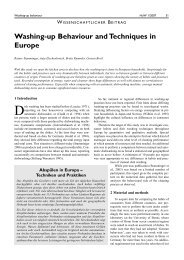Old Washing Machines Wash Less Efficiently and Consume More ...
Old Washing Machines Wash Less Efficiently and Consume More ...
Old Washing Machines Wash Less Efficiently and Consume More ...
Create successful ePaper yourself
Turn your PDF publications into a flip-book with our unique Google optimized e-Paper software.
Comparison Between <strong>Old</strong> <strong>and</strong> New <strong><strong>Wash</strong>ing</strong> <strong>Machines</strong> HuW 3/2005 129<br />
Figure 5a: Index of washing performance of a new washing<br />
machine under varying conditions<br />
index of washing performance �<br />
1.18<br />
1.15<br />
1.12<br />
1.09<br />
1.06<br />
1.03<br />
1.00<br />
0.97<br />
0.94<br />
0.91<br />
0.88<br />
0.85<br />
0.82<br />
0.79<br />
0.76<br />
0.73<br />
0.70<br />
0.67<br />
0.64<br />
0.61<br />
50 100 150<br />
detergent dosage in % �<br />
ratings, which are common in new washing machines (at<br />
rated capacity – which is not used here); <strong>and</strong> for doing so<br />
they usually require increased doses of detergent. <strong>More</strong>over,<br />
the slopes of older washing machines’<br />
performance fields differ signi-<br />
ficantly from that of newer machines,<br />
the loss in performance from<br />
100 % to 50 % detergent dosage<br />
being significantly greater than from<br />
150 % to 100 %. This may be due to<br />
the fact that in older washing machines<br />
there is nothing to prevent sump<br />
losses of detergent. Accordingly, large<br />
proportions of the detergent probably<br />
go unused.<br />
A comparison of the washing<br />
performances achieved in 40, 60 <strong>and</strong><br />
90 °C programmes with the corresponding<br />
amounts of energy used<br />
(Fig. 7) produces results that are<br />
even more surprising. The distribution<br />
of the curves is even less uniform,<br />
<strong>and</strong> it becomes clear that older<br />
washing machines need much more<br />
energy to achieve a good washing<br />
performance. Indeed, to achieve the<br />
same washing performance as new<br />
machines in a 40 °C programme, old<br />
machines must be operated in 90 °C<br />
cycles! <strong>More</strong>over, at 40 °C (the<br />
point furthest left in the graphs), the<br />
W ISSENSCHAFTLICHER B EITRAG<br />
40<br />
60<br />
90<br />
temperature in °C<br />
Source: Own representation<br />
Shaded areas represent classes of washing performance according to the European Energy Label system <strong>and</strong> are for visualisation<br />
only. The machines’ performance with reduced <strong>and</strong> increased doses of detergent at 40 <strong>and</strong> 90 °C was calculated by<br />
linear extrapolation<br />
index <strong>and</strong> class of washing performance �<br />
1,15<br />
1,12<br />
1,09<br />
1,06<br />
1,03<br />
1,00<br />
0,97<br />
0,94<br />
0,91<br />
0,88<br />
0,85<br />
0,82<br />
0,79<br />
0,76<br />
0,73<br />
0,70<br />
A<br />
B<br />
C<br />
D<br />
E<br />
F<br />
G<br />
Figure 5b: Index of washing performance of an old (1975)<br />
washing machine under varying conditions<br />
index of washing performance �<br />
1.18<br />
1.15<br />
1.12<br />
1.09<br />
1.06<br />
1.03<br />
1.00<br />
0.97<br />
0.94<br />
0.91<br />
0.88<br />
0.85<br />
0.82<br />
0.79<br />
0.76<br />
0.73<br />
0.70<br />
0.67<br />
0.64<br />
0.61<br />
50 100 150<br />
detergent dosage in % �<br />
washing performance of old washing machines is much<br />
lower than that of new ones.<br />
50 100 150<br />
detergent dosage in % in 60 °C cotton programme �<br />
90<br />
60<br />
40<br />
temperature in °C<br />
Figure 6: <strong><strong>Wash</strong>ing</strong> performance in 60 °C cotton programme dependent on detergent<br />
dosage (machines are coded by year of production)<br />
-2002<br />
-1975<br />
-1981<br />
-1985<br />
-1983<br />
-1988<br />
-1995<br />
-1992<br />
-1979<br />
-2004<br />
Source: Own representation<br />
<strong><strong>Wash</strong>ing</strong> performance is given as index <strong>and</strong> corresponding class A to G as used by<br />
the European Energy Label. St<strong>and</strong>ard deviation of index of washing performance is<br />
in the same order of magnitude as given in Fig. 7. Lines are for visualisation only





